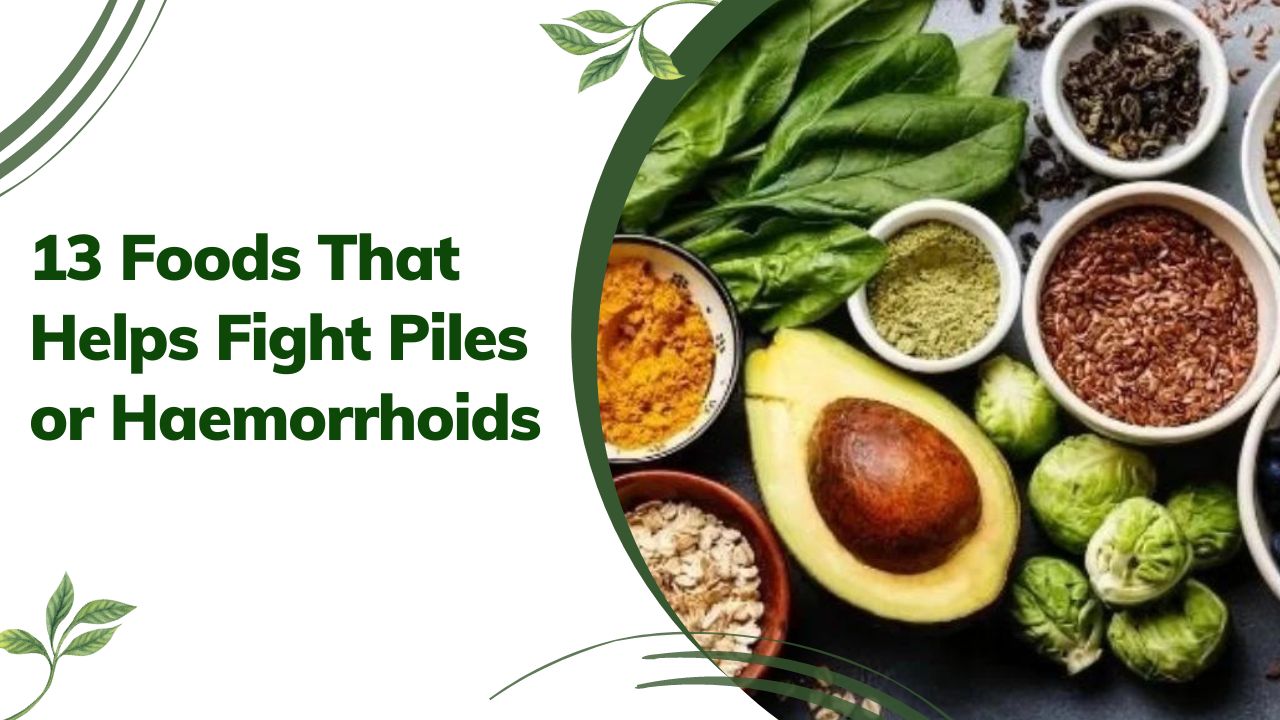Haemorrhoids, or piles, are swollen and inflamed veins in the rectum and anus that cause discomfort and bleeding. There are many different symptoms and causes of piles, such as irritation, bleeding, burning sensations, and itching.
There are effective natural ayurvedic treatment for piles that treat the symptoms and causes. The most important thing to consider is food. A healthy, high-fibre diet helps relieve the symptoms of piles or hemorrhoid’s.
13 Foods to Fight Haemorrhoids
A healthy fibre diet helps increase stool weight and reduces the time faeces spend in the colon.
It increases water retention, resulting in softer stools. Here are some of the fibre-loaded foods that help fight haemorrhoids.
Whole Grains
Whole Grains are nutritional powerhouses. They are rich in insoluble fibre that helps promote proper digestion, giving relief from the pain and discomfort associated with piles.
The options include barley, corn, quinoa, brown rice, whole rye, and oats. Oatmeal is one of the best options to include in your diet, as it is highly fibre-loaded.
Legumes
Legumes like beans, lentils, soybeans, peanuts, and chickpeas are the edible seeds of plants high in fibre.
They are rich in both soluble and insoluble fibers. Depending on their age, adults should get 21–38 grams of legumes each day.
They help bulk up your stool, preventing hemorrhoids and their symptoms.
Cruciferous Vegetables
Cruciferous vegetables such as broccoli, Brussels sprouts, cauliflower, kale, bok choy, radish, and cabbage are good sources of insoluble fibre.
They are best known for their anticancer properties and glycosylate. It diversifies the gut microbiome within 2 weeks. It is a great choice to prevent pile symptoms.
Roots Vegetables
Root vegetables such as turnips, sweet potatoes, carrots, beetroot, and rutabagas are rich in gut-healthy fibre.
Including roasted and steamed root vegetables in your diet will be the best way to fight pile symptoms.
Mashed or roasted ones with skin on them are a good substitute for fries and other foods.
Artichokes
The vegetable is loaded with fibre and helps feed friendly bacteria in the gut. A raw, medium-sized artichoke provides healthy nutrients.
It helps increase bifidobacteria and lactobacilli in the body. It diminishes the symptoms and causes of peptic ulcers, keeping the gut healthy.
Squash
There are a variety of squashes, such as zucchini, acorn squash, pumpkin, and butternut squash, that are high in fibre.
Acorn squash is the most beneficial one for its high fibre content. Including 9 grams of squash in your diet every day would help get rid of the symptoms of piles. You can take the roasted chicken boiled or sautéed.
Celery
Celery is good for delivering a lot of water and fibre to your body; it helps soften the stool and diminish the need to strain.
One large celery provides one gram of fibre and consists of 90% water. Adding it to salads or making a soup or dip will give your food a better taste.
It will help to increase the dietary fibres in your body and give you relief from the symptoms and causes of piles.
Bell Peppers
Another vegetable that is good for piles is the bell pepper. Can provide you with two grams of fibre a day.
Along with that, it is also a hydrating vegetable, containing 93% water. Providing fibre also makes your stool easier to pass, preventing strain and the causes of haemorrhoid symptoms.
Pear
The sweet and sour fruit pair is also fibrous. One medium pair includes 6 grams of fibres and can be added to your daily diet for the same.
Eating it with the peel on is more nutritious, as it has a lot of pile-defying fibres. It can be a good evening or morning snack that can be tossed into soups or salads for a better taste.
Apples
When it comes to fruits, apples are one of the best because they boost energy as well as provide fibre to the body.
One medium Apple provides nearly 5 grams of fibre, which is a good diet for you. It is a soluble fibre that creates a gel-like consistency in the digestive tract.
Apple helps to soften and bulk up the stool, aiding in the discomfort associated with piles.
Cucumber and Melon
Keeping the body hydrated is one of the mandatory things for pile treatment. Cucumbers and melons have 90% water included, so they are good foods to keep your body hydrated.
Along with water, it also includes fibres that are good for your body and improve the digestion process. Eating cucumber with the skin on will ensure you get more fibre.
Banana
Bananas are an ideal food to incorporate into your diet and decrease the symptoms of piles. A banana a day will provide you with a lot of protein and fibre. It even helps boost pectin and resistant starch.
It helps increase friendly gut bacteria and decrease the chances of haemorrhoids.
Raspberries
Raspberries are considered the powerhouse of fibre. Eating one cup of raspberries can provide you with 8 grams of fibre.
Along with that, it even provides 80% of the water your body needs. They are good at depleting the symptoms of piles. Adding raspberries to your salad can give it a tasty twist.
Summary
Piles are usually caused by an unhealthy diet and hard or large stools, so if we keep the diet healthy, it would be helpful in reducing the chances of Piles.
The fruits and vegetables mentioned above are a good diet plan if you have any symptoms of piles. They will help decrease the swollen veins’ burning sensation and itching on the affected area.
Piles can be naturally treated at home, but if you have some severe symptoms, you should get the right diagnosis for them.
Heavy bleeding and pain should not be ignored, and you should get it diagnosed as soon as possible. Along with that, follow a good diet chart that complements your pile of causes.

